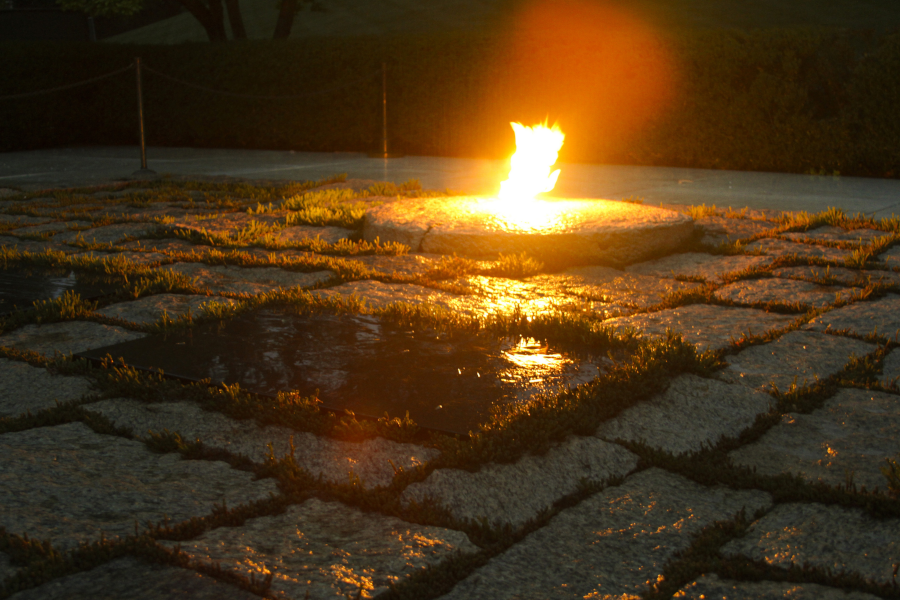
the Corps of Engineers maintains the eternal flame at President John F. Kennedy's grave in Arlington National Cemetery
Source: US Army Corps of Engineers, Norfolk District Image Gallery

the Corps of Engineers maintains the eternal flame at President John F. Kennedy's grave in Arlington National Cemetery
Source: US Army Corps of Engineers, Norfolk District Image Gallery
Arlington National Cemetery was started during the Civil War. Over 250,000 veterans have been buried there since that time. As late as 2018, Civil War soldiers were still being buried there.
The cemetery was located on the grounds of the Arlington Plantation, built originally by George Washington Parke Custis in 1802-1818. He was the grandson of Daniel Parke Custis and Martha Custis Dandridge.
Two years after Daniel Parke Custis died in 1757, his widow married George Washington. Washington's stepson John Parke "Jacky" Custis left his home at Abingdon Plantation (now part of Reagan Washington National Airport) and went to Yorktown in 1781 to join his stepfather. Custis died from disease there in 1781.
George Washington then adopted "Jacky" Custis's two children, George Washington Parke Custis and Eleanor "Nelly" Parke Custis. Nelly lived with her husband Lawrence Lewis at Woodlawn Plantation. Her brother George Washington Parke Custis inherited over 1,000 acres with a hillside that provided a grand views of the new national capital across the Potomac River. He built a Greek Revival home and operated a plantation there which depended upon enslaved labor. He initially called it Mount Washington, but then named it Arlington after an early Custis family plantation on the Eastern Shore.
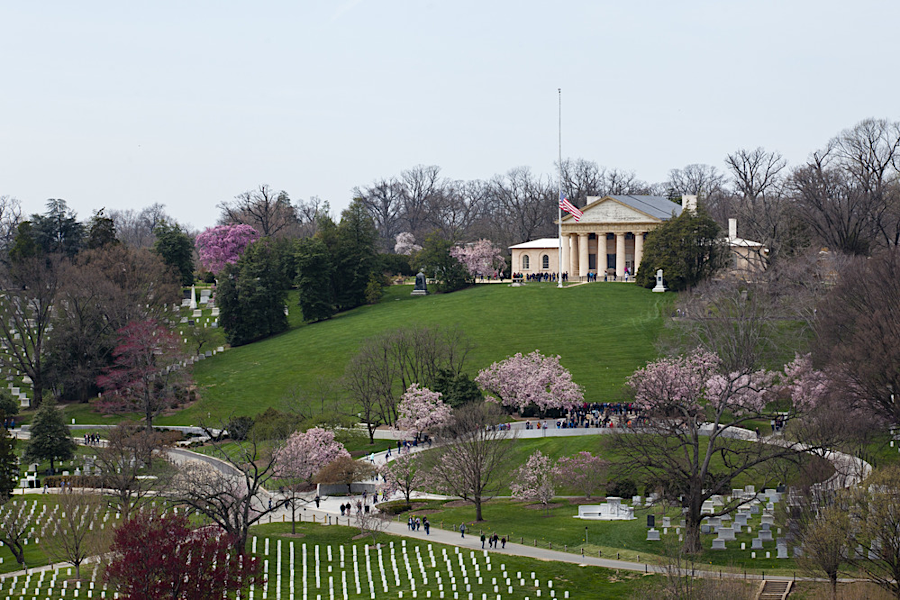
George Washington Parke Custis had a Greek Revival house built on the banks of the Potomac River
Source: National Park Service, Arlington House, The Robert E. Lee Memorial
When George Washington Parke Custis died in 1857, his daughter Mary Anna Randolph Custis inherited Arlington. She had married Robert E. Lee in 1831, and the couple had treated Arlington House as their permanent home since then. They lived there with their seven children whenever Lee was not stationed at a military post. Technically the property was owned just by Mary Custis Lee after her father died in 1857, but in that time period husbands were treated as the master of the family.1
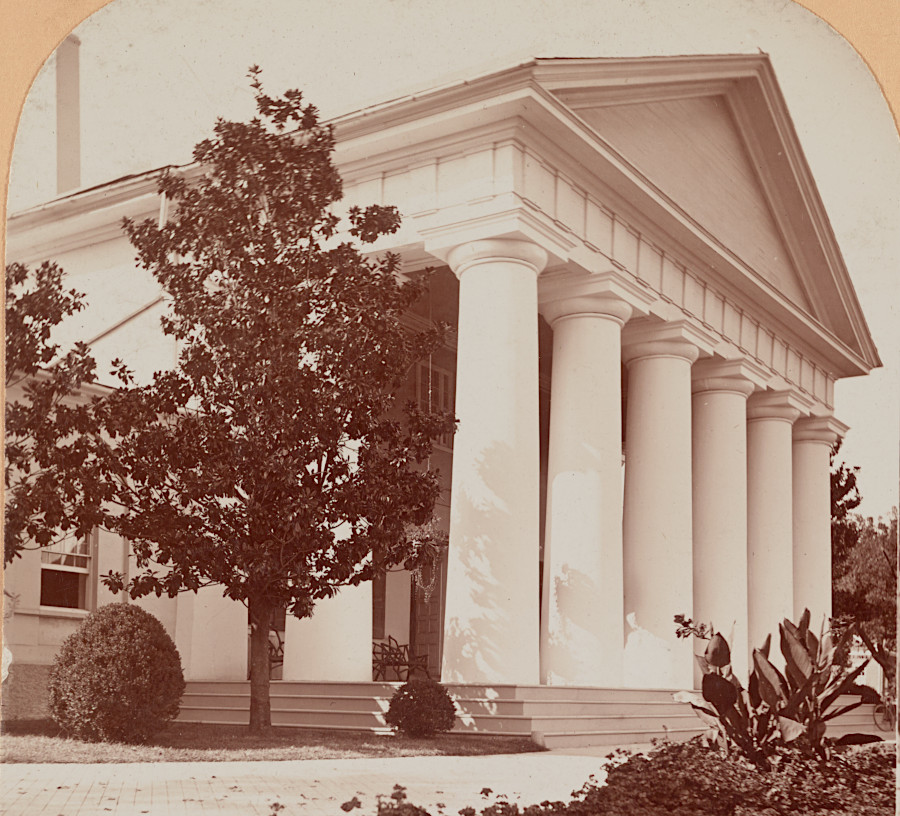
Robert E. Lee's wife, Mary Anna Randolph Custis, inherited the mansion house
Source: Library of Congress, Arlington House - Lee's old home, Arlington Va., U.S.A.
Just prior to the start of the Civil War, Robert E. Lee resigned his commission in the US Army and chose to serve the state of Virginia when it seceded from the Union. The Union Army could not allow an enemy force to occupy the heights at Arlington with a commanding artillery position that could threaten the Federal capital, so Lee knew that his home would be seized as soon as Virginia was invaded. He wrote his wife from Richmond on April 26, 1861:2
She fled just before Federal troops crossed the Potomac River on May 24, 1861. They converted the plantation initially into a fortified position to protect Washington from a Confederate attack, and newly-freed slaves bult a Freedman's Village there.
In 1862 the US Congress passed legislation to collect taxes on real estate in "insurrectionary districts" and required landowners to pay them in person. Mary Custis Lee sent a family member to pay, but the Federal commissioners rejected that attempt. Instead, they confiscated Arlington Plantation and sold it at auction on January 11, 1864. Only the Federal government submitted a bid.
The start of the Overland Campaign in May, 1864 dramatically increased Union casualties. Graveyards in the Washington, DC area were incapable of accommodating the dead, so Quartermaster Montgomery Meigs chose to bury them at Arlington.
The first burial was on May 13, 1864. Private William Christman of the 67th Pennsylvania Volunteer Infantry Regiment, had died of disease two days earlier.
He was buried near the pre-existing plantation graveyard for enslaved people and freed blacks. Other early burials occurred there in the "Lower Graveyard," probably because Union officers occupying the mansion house wanted the graves to be far away from the building.
Montgomery Meigs had the exact opposite plan, and insisted that burials occur next to Lee's home. He evicted the officers living in Arlington House and had graves for officers dug in Mrs. Lee's garden near the front door.
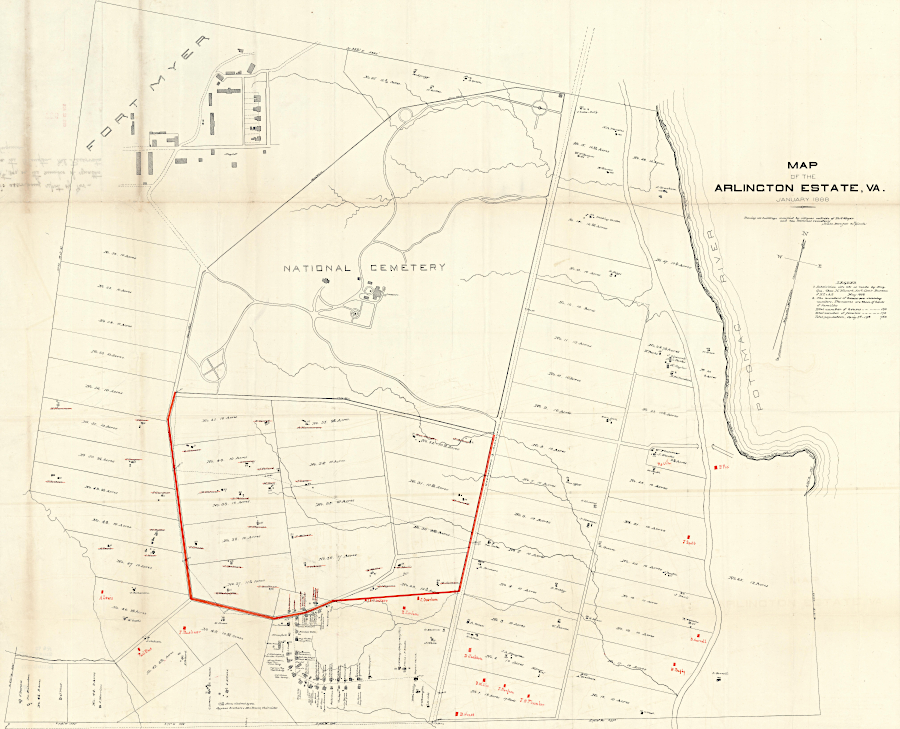
Arlington Memorial Cemetery in 1888
Source: National Archives, Map of the Arlington Estate, Virginia
Meigs wanted to make it impossible for the Lee family to reoccupy the house:3
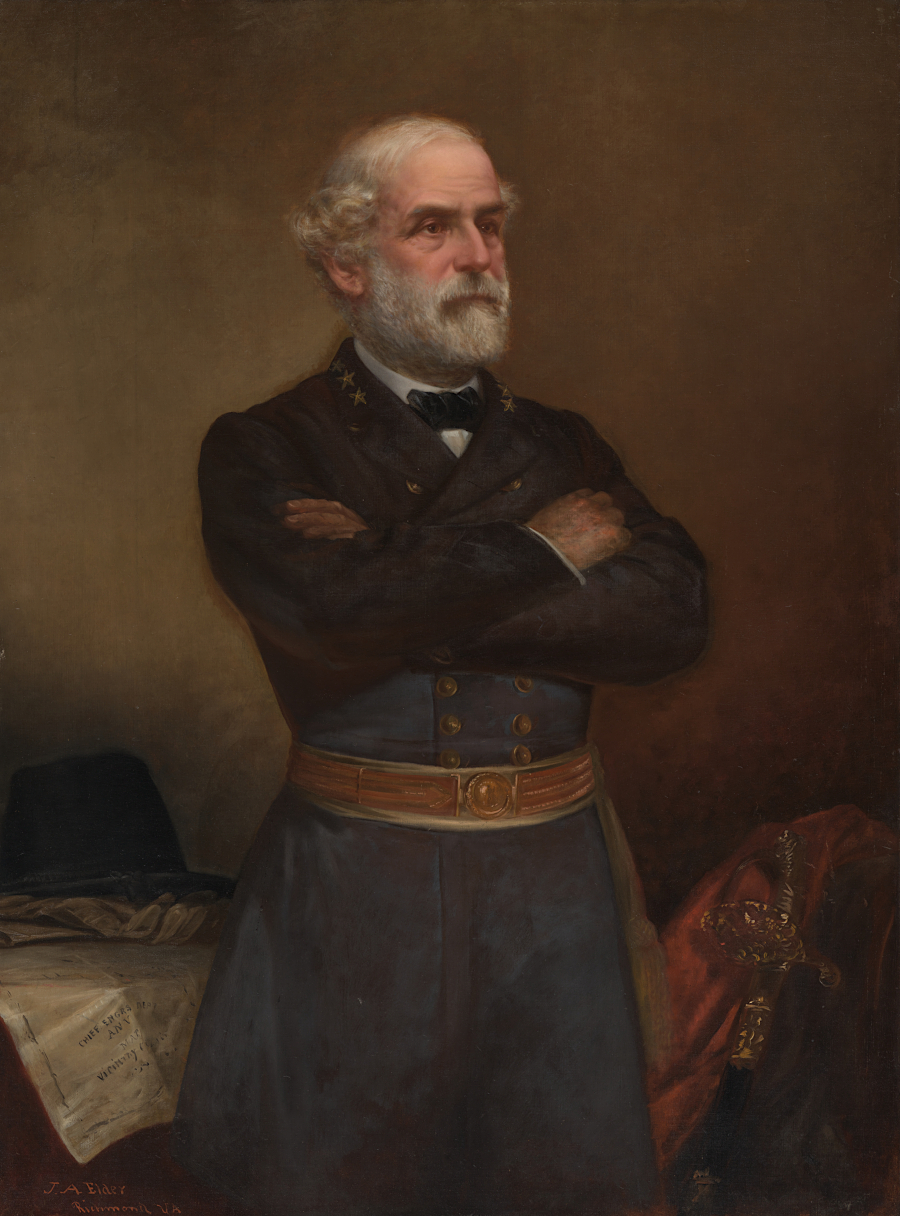
while Robert E. Lee led the Army of Northern Virginia, Montgomery Meigs converted the place where he had lived into a cemetery
Source: Smithsonian Institution, Robert Edward Lee (by John Adams Elder, 1876)
The Secretary of War issued a proclamation on June 15, 1864 designating Arlington plantation as a national cemetery. After that date, burials were segregated by race until President Harry Truman desegregated the armed forces in 1948.
There were 1,000 burials between May 1864-June 1864, before that proclamation created a segregated cemetery. In the Lower Cemetery, what is now Section 27 of Arlington National Cemetery:4
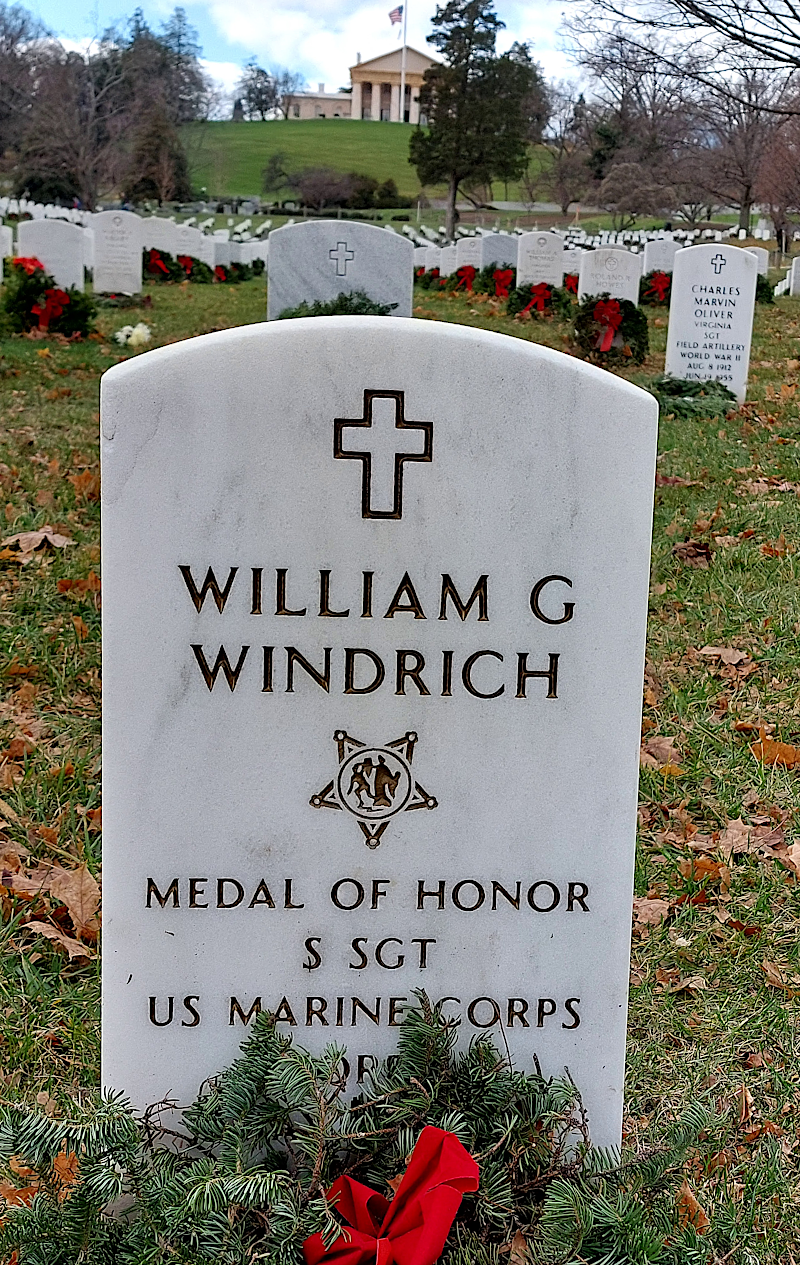
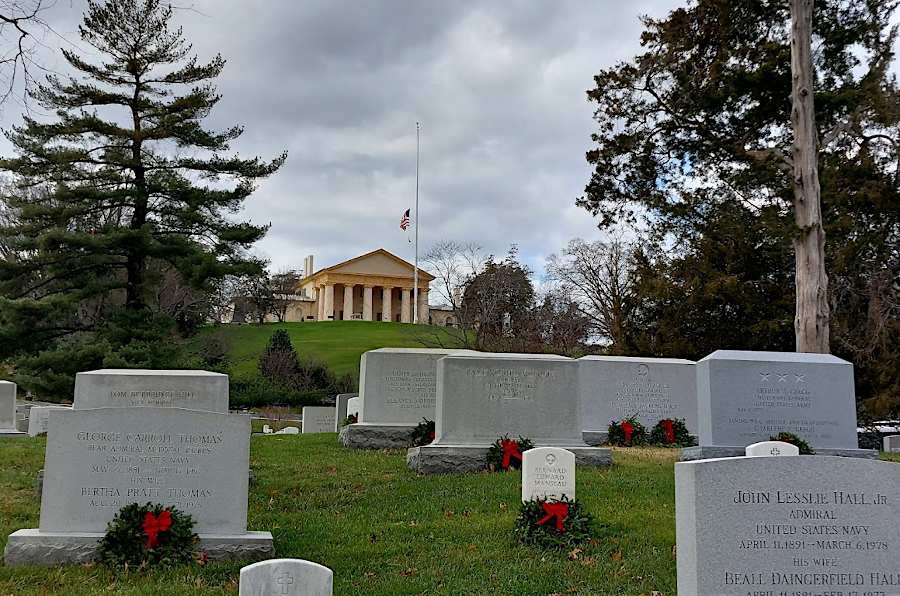
the Arlington mansion house is now surrounded by graves
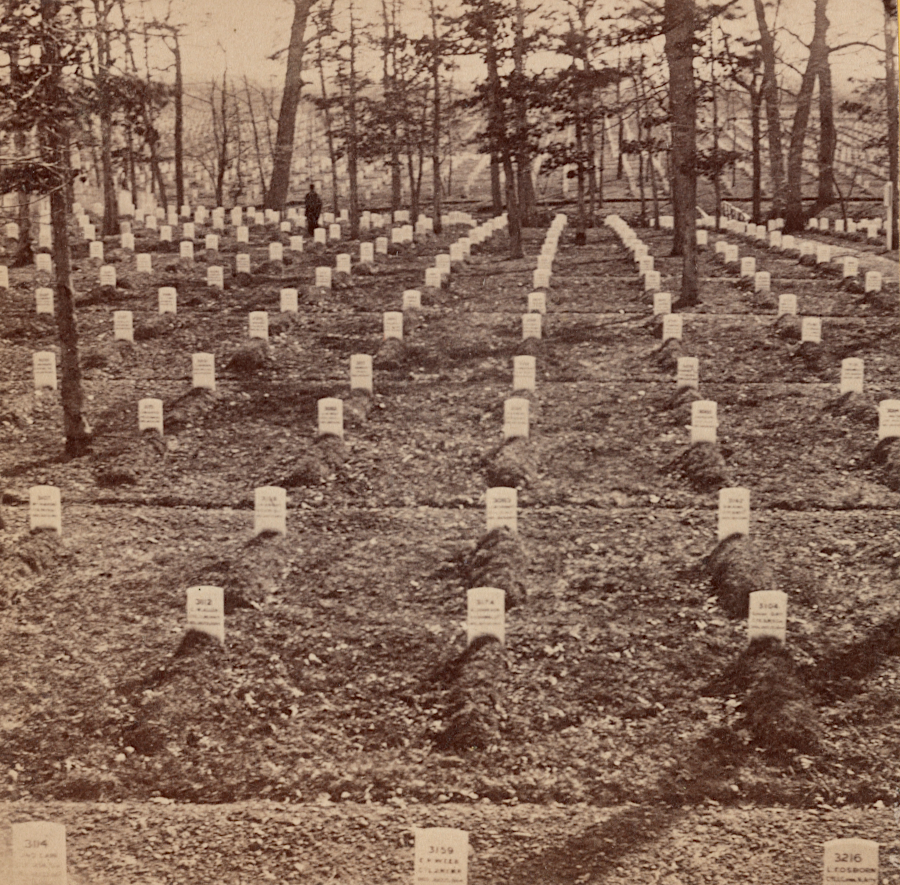
long rows of graves at Arlington National Cemetery were fresh in 1867
Source: Library of Congress, National Cemetery, Arlington, Va. (c.1867)
The War Department refused in 1871 to relocate the graves of United States Colored Troops (USCT) from the Lower Cemetery to the main cemetery where white soldiers were buried. Approximately 1,500 members of the United States Colored Troops are now in Section 27 at Arlington. There are also about 3,800 African American "freedpeople" buried there, but apparently none of those came from the population of previously enslaved people living in Freedman's Village.
The first two unknown soldiers were buried on May 15, 1864.
Montgomery Meigs had 2,111 unknown soldiers excavated from Northern Virginia burial sites and transferred to a pit dug near the mansion house, and later had his own son buried at that site. The Tomb of the Civil War Unknowns, now in Section 26 of Arlington National Cemetery, is assumed to include the remains of both Confederate and Union soldiers. The remains of over 5,000 unknown soldiers are now at the cemetery.
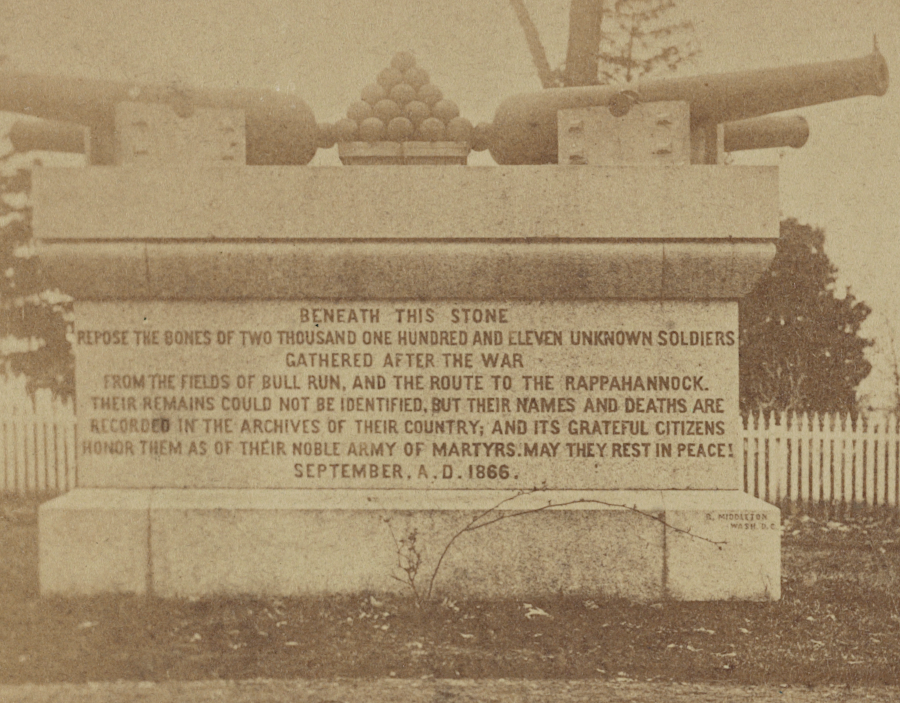
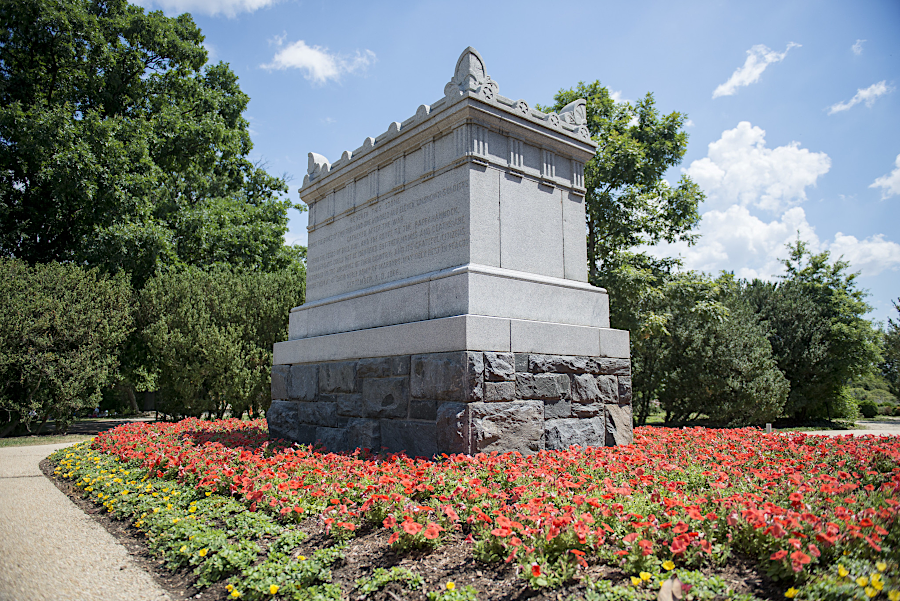
the bones of 2,111 soldiers were collected from cemeteries between Bull Run and the Rappahannock River and reburied in a masonry vault in September 1866
Source: Library of Congress, Washington, D.C. - Tomb of the Unknown Civil War Soldiers and Arlington National Cemetery, Tomb of the Civil War Unknowns
In late 1865, after the end of the Civil War, Robert E. Lee sent his older brother Smith Lee to inspect his wife's estate. It might have been possible to remove the graves and make it possible to live in the plantation house again, but Federal officials had placed enormous tombstones on officers graves and made their removal impossible. Robert E. Lee died in 1870, and Mary Custis Lee visited Arlington for one last time in Arlington in June 1873. Seeing the transformation of the site, she abandoned efforts to return there before dying several months later.
Her oldest son, George Washington Custis Lee, inherited the Lee claim to the plantation. He petitioned Congress for compensation, without requesting the graves be removed or that title be transferred back to his family. After his petition was rejected, he filed a lawsuit in Federal court. He claimed the tax sale was not legitimate, and asked a court to order eviction of trespassers who had occupied the site since the 1864 auction. In 1882, the US Supreme Court ruled in his favor and declared the seizure ("taking") without compensation to have been unconstitutional. At that point, there were 20,000 graves at Arlington.
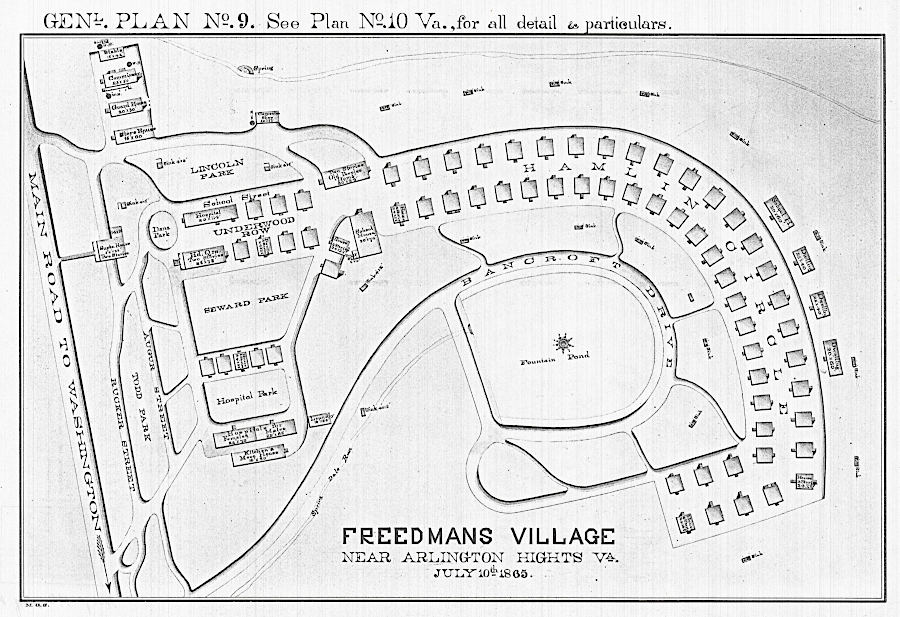
Freedman's Village developed on the grounds of the Arlington mansion
Source: Library of Congress, Arlington National Cemetery: Where Every Day We Remember

Freedman's Village was closed in 1900
Source: Library of Congress, Freedmans village--Greene Heights Arlington, VA
Custis Lee negotiated a sale price and transferred ownership of the site to the Federal Government in 1883. In the end, more members of the Meigs family ended up buried at Arlington than members of the Lee family.5
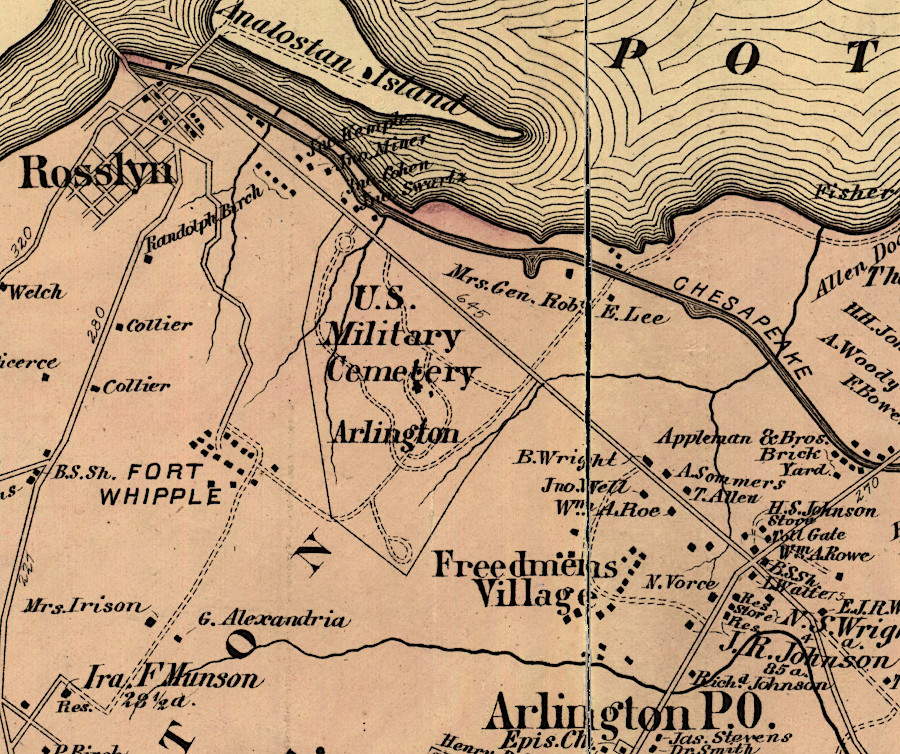
an 1878 map included the residence of Mrs. General Robert E. Lee
Source: Library of Congress, Atlas of fifteen miles around Washington, including the counties of Fairfax and Alexandria, Virginia (by Griffith Morgan Hopkins, Jr., 1878)
The only person who was born and also buried at Arlington Plantation is James Parks. He was an enslaved man there until the Union occupation in 1861, and was one of the early gravediggers for soldier burials. His description of the site before 1861 provided essential evidence for restoration of the mansion house to its historic appearance. When James Parks died in 1929, he was buried with full military honors.6
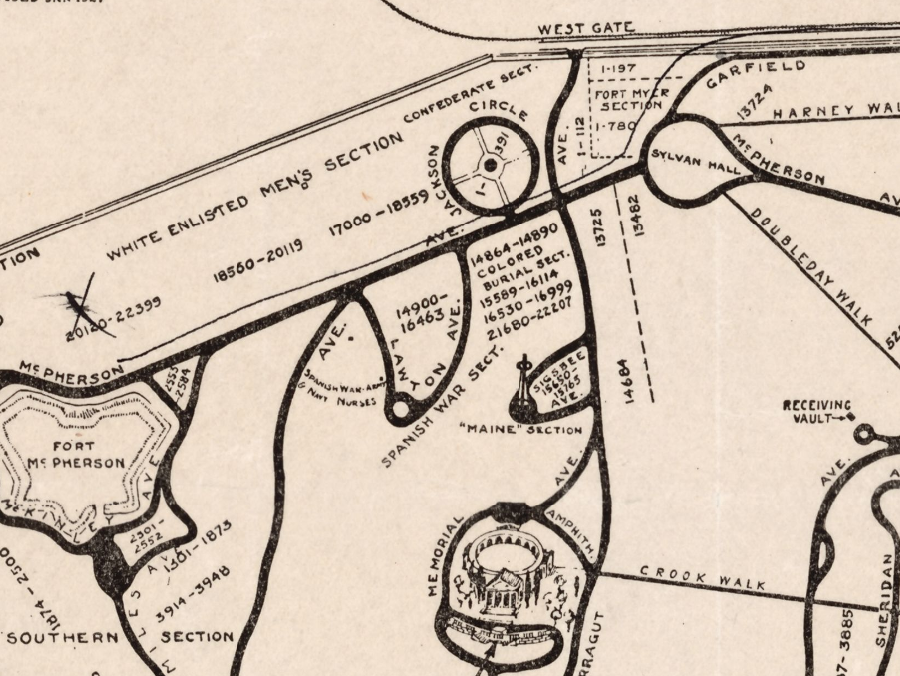
white and "colored" sections were established for burial at Arlington National Cemetery
Source: Library of Congress, Map of the Arlington, Va. National Cemetery showing drives (1927)
After the Civil War, Confederate veterans were excluded from burial at Arlington. Four days after the Spanish-American War ended in 1898, after many young men from southern states had served in the United States Army, President William McKinley announced that former Confederates were now eligible for internment. Congress funded relocation of Confederate remains from graves near Washington DC, which the United Confederate Veterans located.
Over time, at least 400 Confederate soldiers ended up in Section 16. In contrast to other sections, the headstones have pointed tops and the graves are aligned in concentric rings.
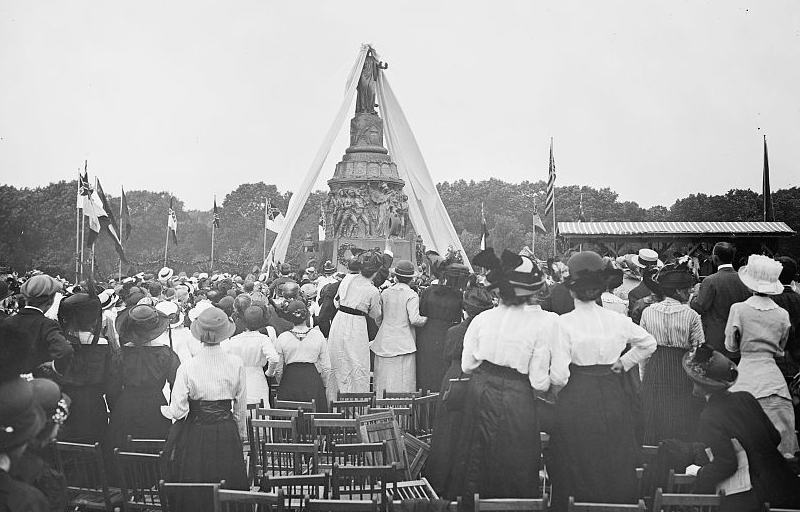
a memorial to honor Confederate soldiers was unveiled in 1914 in Section 16 of Arlington National Cemetery
Source: Library of Congress, Unveiling Confederate Monument, Arlington
The Confederate Memorial to Reconciliation and Reunification was constructed in 1914 to honor the Confederate soldiers. The sculptor, Moses Ezekiel, was buried at its base seven years later. As interpreted by one observer, the monument includes a:7
The Daughters of the Confederacy had an inscription placed at the base. The Latin phrase came from a poem in which Caesar won a military battle and became a dictator, but the philosopher Cato admired more the honor of his opponents. The inscription highlights the "Lost Cause" perspective that permeated the Southern interpretation of the Civil War for 150 years:8
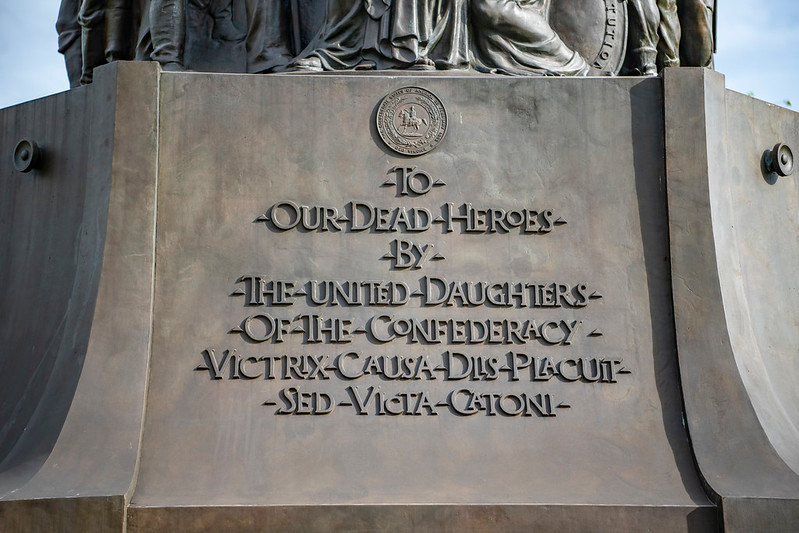
the Daughters of the Confederacy provided the Confederate Memorial to Reconciliation and Reunification at Arlington National Cemetery
Source: Arlington National Cemetery, Confederate Memorial in Section 16
At the dedication of the monument, President Woodrow Wilson said:9
After the murder of George Floyd in 2020, the Commission on the Naming of Items of the Department of Defense ("Naming Commission") recommended replacing names of military facilities which were associated with the Confederacy. In its third report, issued in September 2022, the commission proposed dismantling the Confederate Memorial to Reconciliation and Reunification and removing it from Section 16 in Arlington National Cemetery. The Secretary of Defense endorsed the recommendation.
In 2023, the Virginia Military Institute (VMI) agreed to accept the memorial, if transferred out of Arlington National Cemetery, and install it at the Virginia Museum of the Civil War at New Market Battlefield State Historical Park. It commemorated the 1864 Battle of New Market, in which 257 VMI cadets had fought and 10 had died.
In 2020, VMI had transferred its statue of Confederate General Thomas "Stonewall" Jackson from a prominent site in front of the barracks to that park. Moses Ezekiel, a VMI graduate, had designed both monuments.
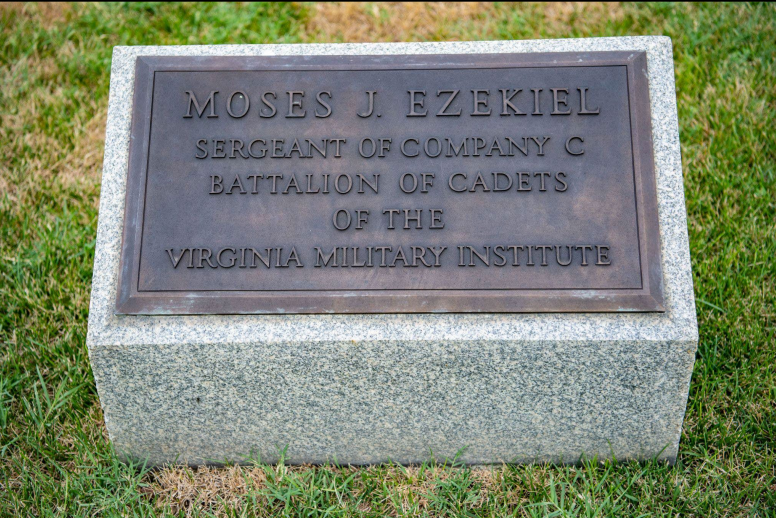
sculptor and Confederate veteran Moses Ezekiel is buried at the base of his Confederate Memorial in Arlington National Cemetery
Source: Arlington National Cemetery, Phase II Intensive-Level Survey of the Confederate Memorial (000-1235) (Figure 26)
A DefendArlington group organized and attempted to keep the monument at Arlington National Cemetery. One advocate commented:10
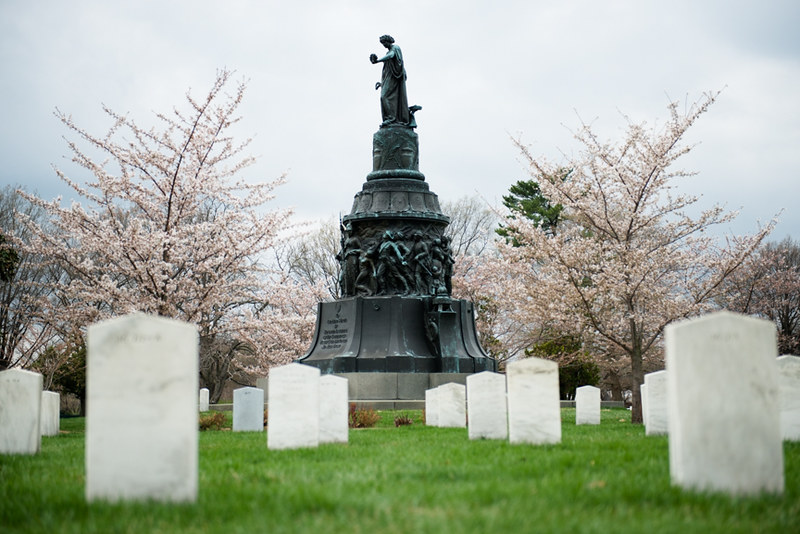
the Confederate Memorial was in Arlington National Cemetery between 1914-2023
Source: Arlington National Cemetery, Confederate Memorial
There were two last-minute lawsuits to block the removal of most of the Confederate Memorial to Reconciliation and Reunification. A judge issued a temporary restraining order after Defend Arlington claimed that graves were being disturbed, but quickly lifted the restraining order after a personal visit to the site. The 32-foot bronze statue and surrounding frieze were removed on December 20, 2023.
In a parallel effort, three Republican legislators in the General Assembly called for Governor Youngkin to bar from any state contracts the company handling the removal. Team Henry Enterprises, the contractor, had previously handled removal of Confederate memorials on Monument Avenue in Richmond.
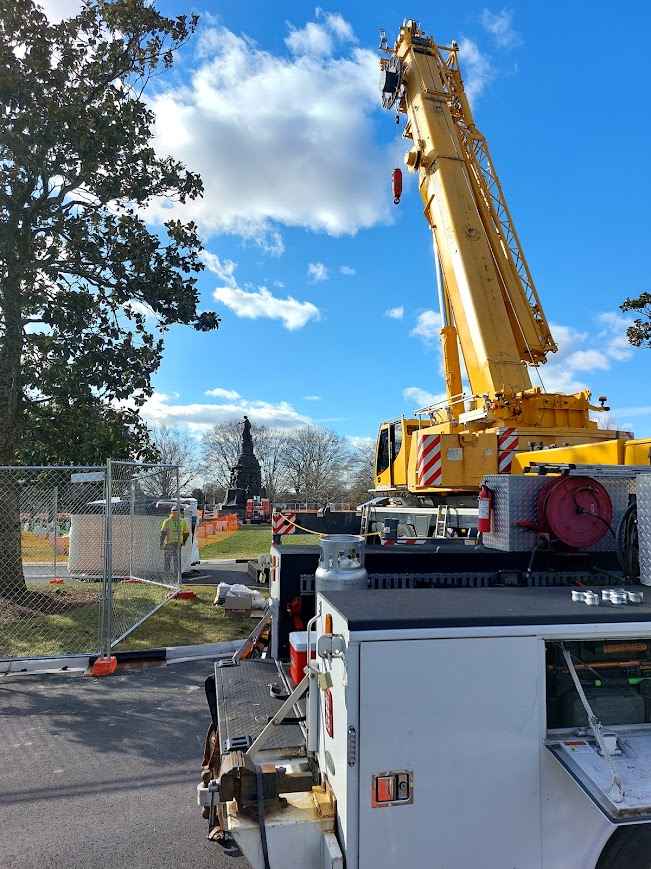
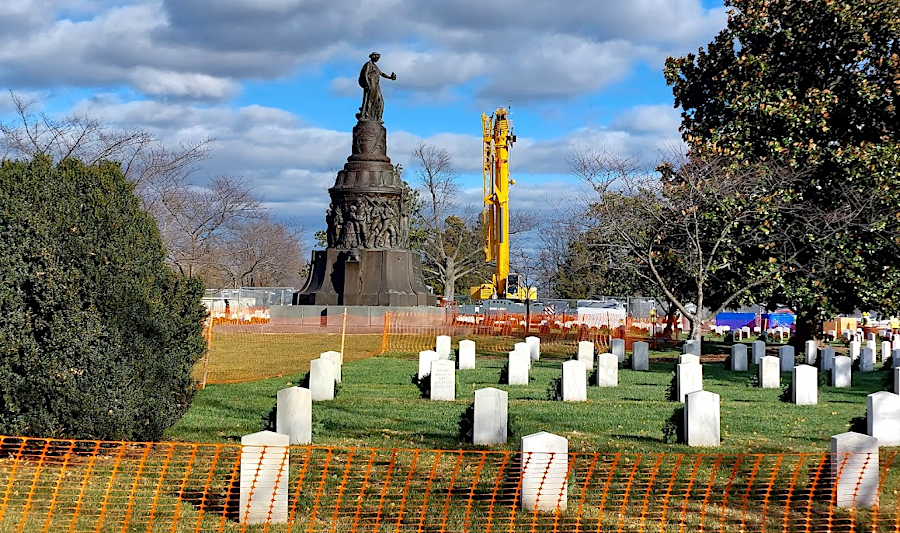
preparing to remove the Confederate Memorial in Section 16 (December 18, 2023)
Removal was the final act of the Naming Commission, and it met the end-of-2023 deadline for addressing the 1,111 named items that commemorated the Confederates. Prior to the Naming Commission recommendation and then removal of the Confederate Memorial to Reconciliation and Reunification, Arlington National Cemetery provided cultural context for it on its website:11
In June 2024, the US House of Representatives considered legislation that would require returning the memorial to Arlington National Cemetery. An amendment to the National Defense Authorization Act of 2024 received 192 votes, but was defeated when 230 members opposed it.
On August 5, 2025 during the second Trump Administration, Secretary of Defense Pete Hegseth announced that the memorial would be restored to Arlington. The statue was stored in a Virginia warehouse, and Governor Youngkin supported the reinstallation. Completion of the project, with new interpretive panels, was projected to occur in 2027 and cos t$10 million.
Hegseth declared:12
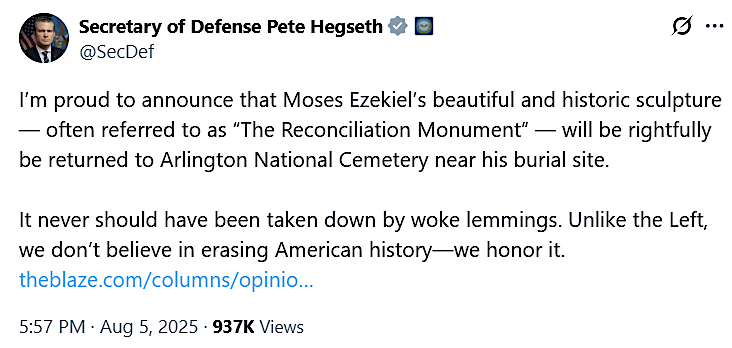
President Trump's Secretary of Defense decided to restore The Reconciliation Monument to Arlington National Cemetery in August, 2025
Source: Secretary of Defense Pete Hegseth, post on X (August 5, 2025)
The design of the mansion house at the cemetery was used as the central visual element when Arlington County informally created a county logo starting in the 1960's. The county seal and flag were officially adopted on June 18, 1983. A stylized version still using the mansion columns was approved in 2004.
In 2020, a completely new logo was chosen that omitted any reference to the mansion. That change was of many initiatives to modify or remove memorials to prominent Confederates, after the death of George Floyd spurred nationwide reconsideration of race relations.
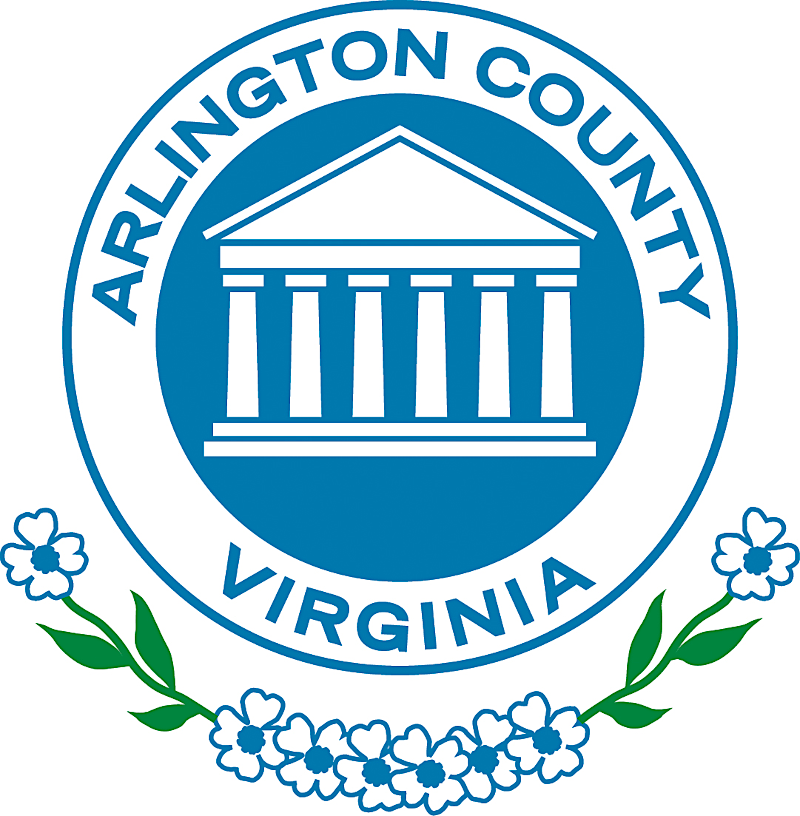
the Arlington County logo adopted in 1983 prominently incorporated the columns of the Arlington Mansion
Source: Arlington County Library, The History of Arlington's Logo and Seal

in 2020 Arlington County replaced its 2004 stylized logo with a new one that had no visual reference to Robert E. Lee's mansion
Source: Arlington County Library, The History of Arlington's Logo and Seal and Arlington County, New County Logo
The mansion house is managed by the National Park Service, and was labelled "Arlington House, the Robert E. Lee Memorial" in 1972. A bill was introduced in the US Congress in 2020 to rename the site to just "Arlington House." However, Congress did not approve the bill and the name remained "Arlington House, the Robert E. Lee Memorial."
In 2023, over 100 descendants of the families of Robert E. Lee and of the enslaved workers at Arlington, including a descendant of James Parks, gathered at the mansion to commemorate their shared heritage. The families wore T-shirts saying "Ask me about my family" and asked the US Congress to rename the site as just "Arlington House National Historic Site."
A descendant of Charles Syphax, one of those who had been enslaved, said:13
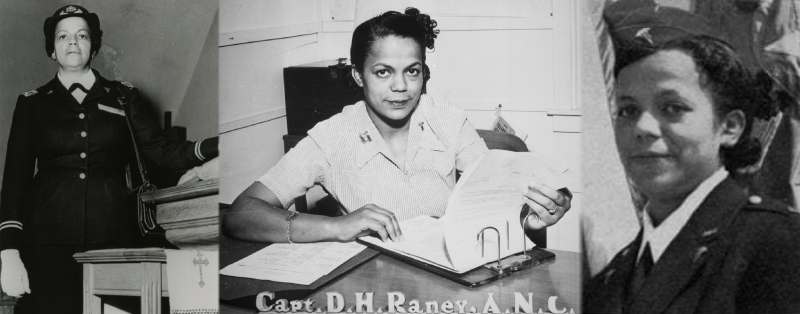
Della Hayden Raney Jackson, who achieved the highest rank of any African American nurse in World War II, is buried at Arlington National Cemetery
Source: Veterans Administration, #VeteranOfTheDay Army Veteran Della H. Raney Jackson
The US Army retained responsibility for Arlington National Cemetery and the cemetery at the Soldiers Home in Washington DC, after a 1973 law transferred most military cemeteries to the Department of Veterans Affairs. The National Park Service is responsible for 14 other military cemeteries on historic battlefields such as Gettysburg, and the American Battle Monuments Commission is responsible for 26 American military cemeteries in 17 foreign countries.
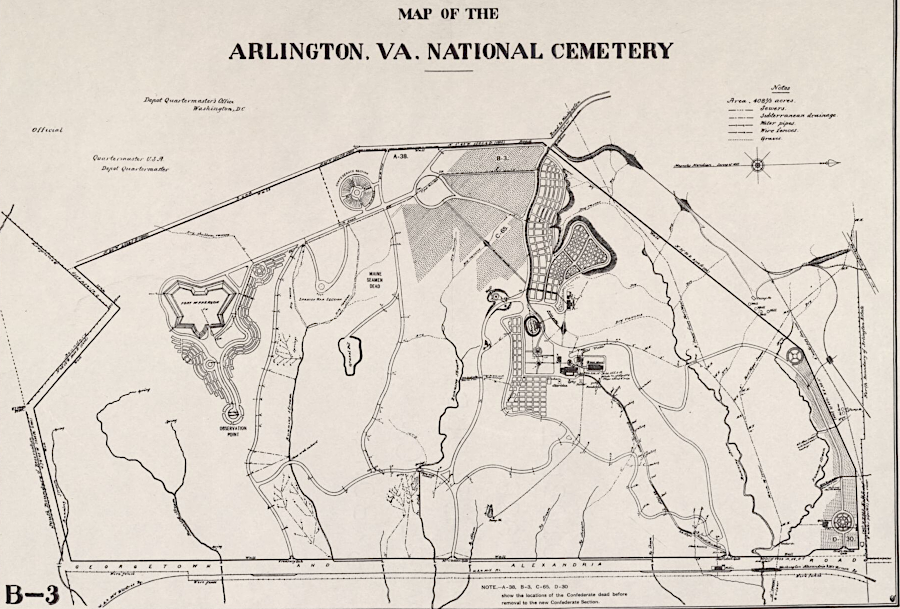
Confederates were reburied in Arlington National Cemetery
Source: Library of Congress, Map of the Arlington, Va. National Cemetery (1901)
In 2009, Salon began publishing articles about a hostile work environment and irregularities in budgeting and management at Arlington National Cemetery. As reported in the Washington Post in 2010:
A criminal investigation was opened after the remains of eight cremated bodies were discovered in one mass grave. Exhumations proved that a few graves contained more than one body, or the wrong body.
The US Army committed to digitize the 500,000 paper records documenting 330,000 burials, including 220,000 markers and another 43,000-some columbarium niches. Maps did not match on-the-ground findings; some locations marked as having no graves were found to have headstones, while areas with no markers were discovered to have burials. Some older markers had been lost, and during the 1920's and 1930's many spouses had been buried without adding their name to the tombstone.
Roughly 25% of the records had to be reconciled. After the US Army completed an accurate inventory of all burials, threats to move Arlington National Cemetery to the Department of Veterans Affairs were dropped. It turned out that one soldier had a grave for his amputated leg, and a second grave for the rest of him when he died many years later.14
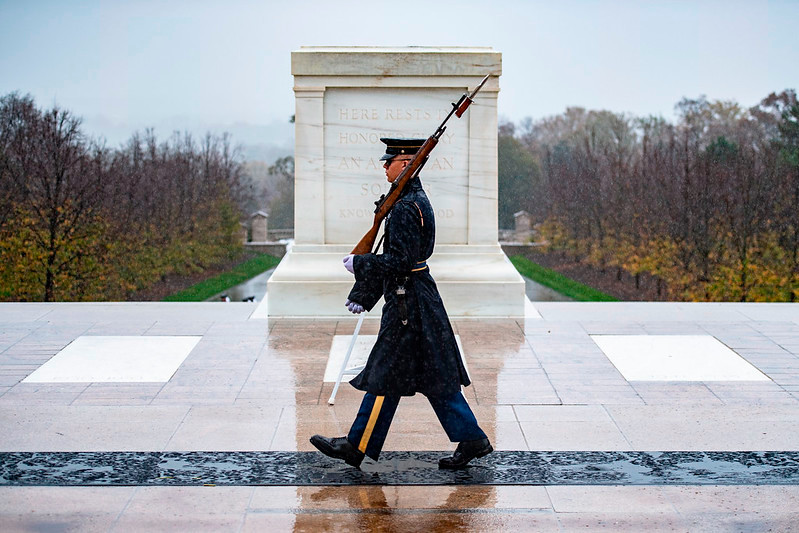
the Tomb of the Unknown Soldier is honored with a guard at all times
Source: Arlington National Cemetery, 69th National Veterans Day Observance at Arlington National Cemetery
The most recent Civil War burial at Arlington occurred in 2018.
In 1862, after the Second Battle of Manassas, two Union soldiers were interred on the battlefield west of the Stone House. Their bodies were placed in a pit together with nine legs and two arms that had been amputated from other soldiers. In 2014, The National Park Service discovered the pit and bones when excavating a utility line on the Second Manassas battlefield west of the Stone House.
In 2015, archeologists carefully excavated the site. It revealed how Civil War doctors had performed surgery, including bones with bullets still buried in them. A Smithsonian anthropologist commented:15
Arlington National Cemetery chose to bury the two soldiers in the first graves of a new 27-acre section created in the Millennium Project. The soldiers killed in 1862 and excavated in 2015 were buried, for a second time, in 2018.16
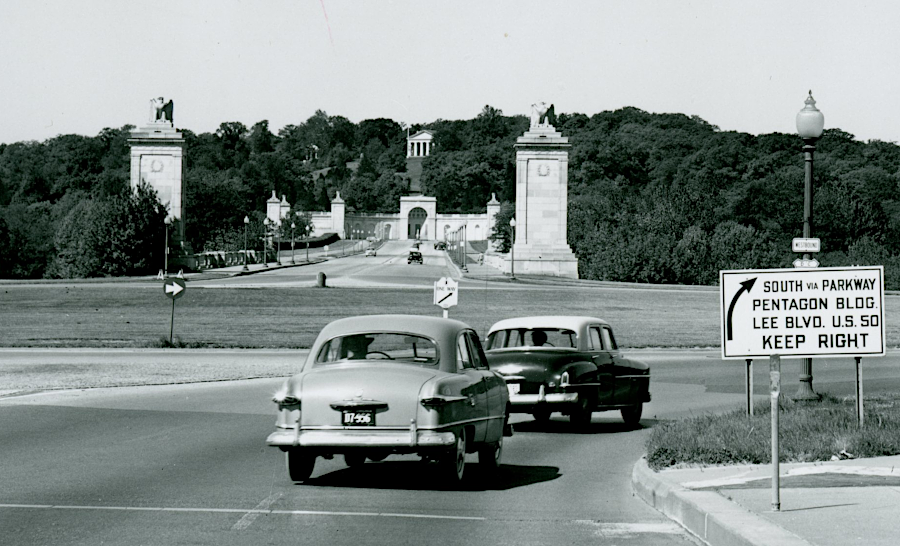
view of Custis-Lee Mansion from Memorial Bridge in 1952
Source: National Archives, Signs Near Memorial Bridge
In 2020, Arlington County endorsed plans to expand the cemetery by 70 acres. The Navy Annex had already been removed in anticipation of the expansion. 37 acres would be used for adding 60,000 more gravesites. That would prevent the cemetery from becoming "full" in 2043 and accommodate demand until 2060.
The expansion area included the Air Force Memorial, and the project also realigned Columbia Pike to add sidewalks and bike paths. Arlington County and the US Army tried to negotiate a land swap, because the expansion included nine acres of county-owned land. Roads occupied five acres, but Arlington County claimed it could build housing on four acres
The military disputed that claim and the value of the property. In 2017, the US Government used its power of eminent domain to "take" the land. That allowed expansion planning to proceed, while the two parties sought to determine the payment due to Arlington County for the value of the four acres.
Negotiations failed and the dispute finally ended up in Federal court in 2023. The county valued the four acres at $21 million, claiming that 50 townhomes could be constructed there. The Federal government claimed a previous transfer of the land from the Federal government to the county required the land to be used only for roads, and told the judge:17
The expansion added 70 acres.
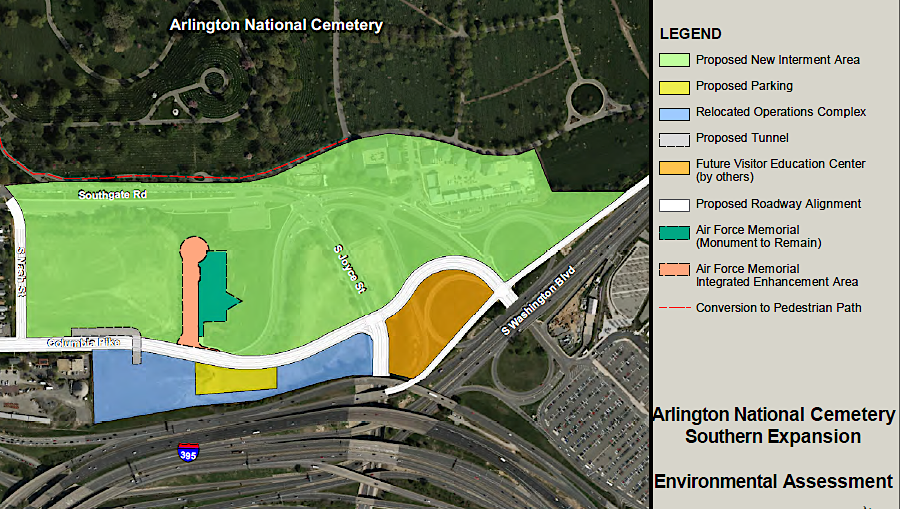
Arlington County and the US Army agreed in 2020 on plans to expand Arlington National Cemetery
Source: US Army, Arlington National Cemetery - Final 2019 Environmental Assessment for the Southern Expansion and Associated Roadway Realignment (Figure 2-15)
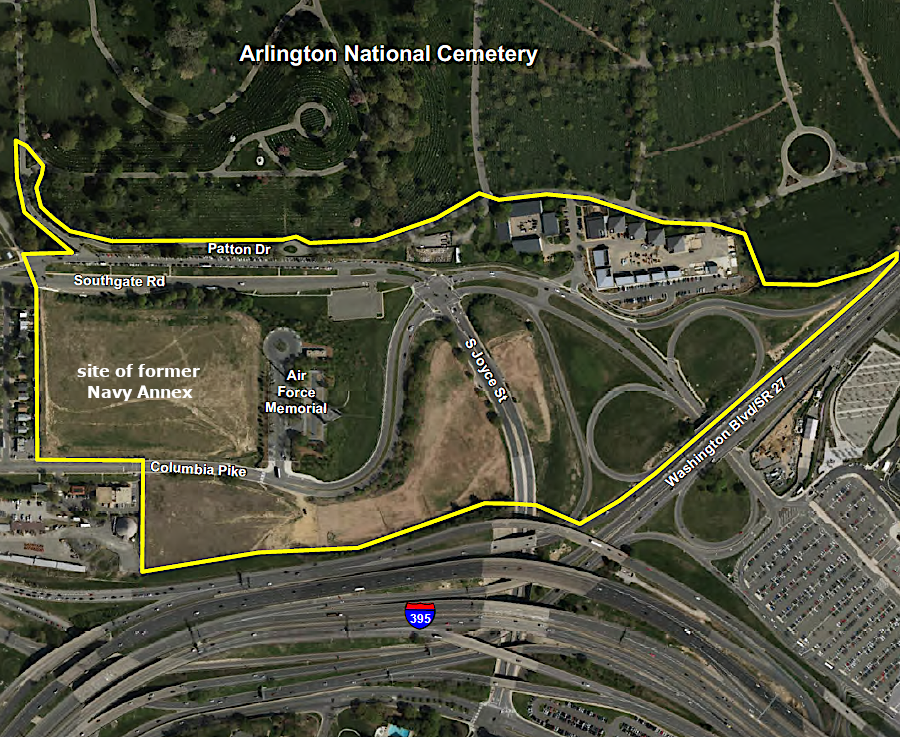
adding 70 acres to Arlington National Cemetery will create space for 60,000 burial plots
Source: US Army, Arlington National Cemetery - Final 2019 Environmental Assessment for the Southern Expansion and Associated Roadway Realignment (Figure 1-2)
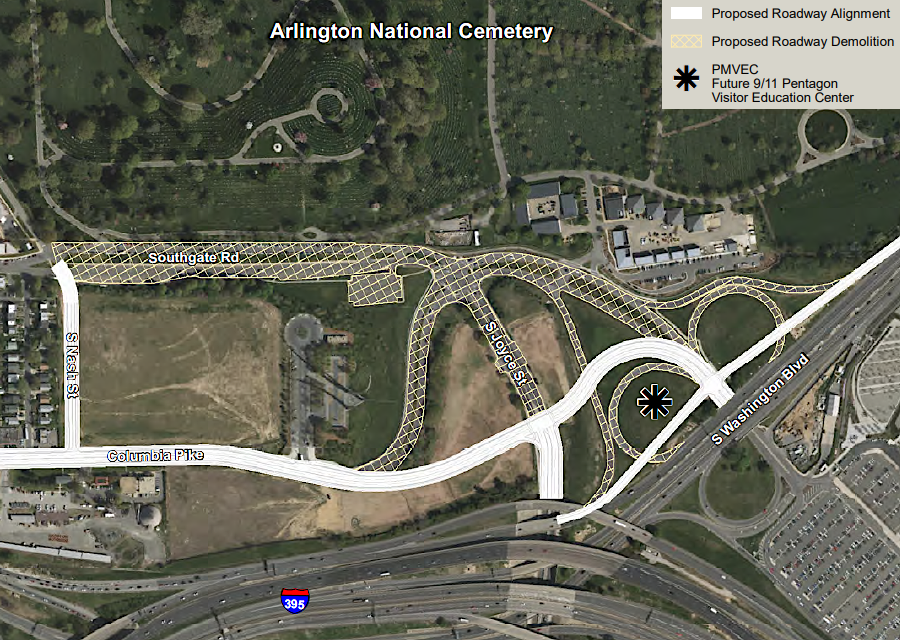
expanding Arlington National Cemetery will require realignment of Columbia Pike
Source: US Army, Arlington National Cemetery - Final 2019 Environmental Assessment for the Southern Expansion and Associated Roadway Realignment (Figure 2-1)
Also in 2020, the Secretary of the Army proposed new eligibility rules limiting who might be buried at Arlington National Cemetery, planning for it to remain open for another 150 years. Many of those who had served in the military would remain eligible for above-ground "inurnment" in a columbarium, which required far less dedicated space per burial underground.
The proposed revision explained the math that drove the Army to propose excluding most veterans with combat service from below-ground interment at Arlington, except those who were killed in action, served as prisoners of war, or met several other narrow criteria:18
The new rules allowed a select group to qualify for in-ground burial:19
- those killed in action
- award recipients of the Silver Star and higher who also served in combat
- Purple Heart recipients
- former prisoners of war
- presidents and vice presidents of the United States
- those who died in combat-related service deaths while conducting uniquely military activities
In 1992, Worcester Wreath Company in Maine had extra unsold wreaths in December. The company partnered with other organizations to donate the wreaths and have them placed at headstones in lesser-visited sections of Arlington National Cemetery. That practice continued without a great deal of public recognition until, in 2005 a picture of wreaths at the cemetery "went viral" on the Internet.
To deal with requests for wreaths at other national cemeteries and offers to help, Wreaths Across America was formed in 2007 as a non-profit 501(c)(3) organization. In 2014, it placed wreaths at all 226,525 headstones in Arlington National Cemetery and has continued to do so. More than 260,000 live balsam wreaths were used in 2023. At 3,000 other locations, 3,000,000 wreaths decorated graves.20
The first caisson burial was held at Arlington Memorial Cemetery in 1888. By 2022, the U.S. Army Caisson Detachment of the 3rd US Infantry Regiment had 52 soldiers who cared for the horses, after receiving 10 weeks of training. Soldiers rotated through the assignment, but a civilian served as the permanent manager overseeing the herd.
The horses were kept at Fort Myer and on a six-acre pasture complex at Fort Belvoir. There was not adequate pasture or space at the two facilities for the 60-horse herd. Two acres of pasture per horse was the standard recommended by the American Association of Equine Practitioners.
Burials involving horse-drawn caisson were suspended in April 2023 after several horses died. A RAND study in 2024 recommended restricting the eligible burials so only two missions per day would be required (rather than as many as eight), reducing the herd to 24-28 horses, and contracting with professional equine operators to maintain a healthy herd.
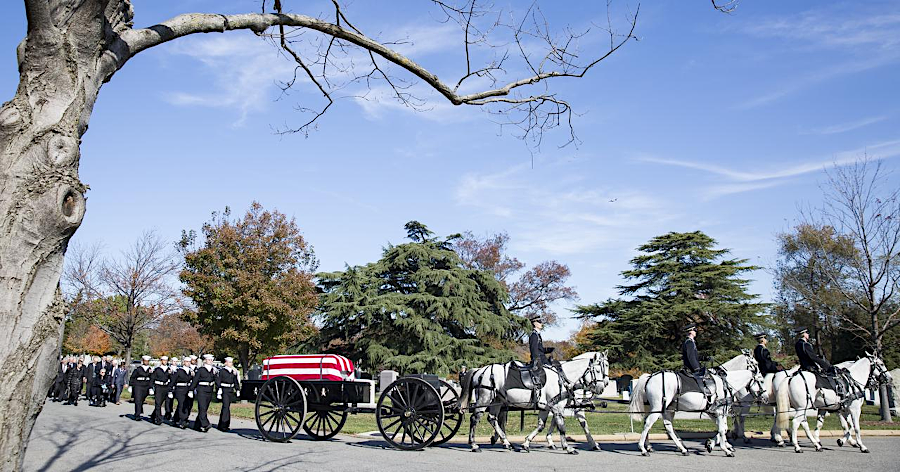
in-ground burial ceremonies can include ritual transport via a horse-drawn carriage
Source: National Aeronautics and Space Administration (NASA), Alan Bean Interment (2018)
One finding was:21
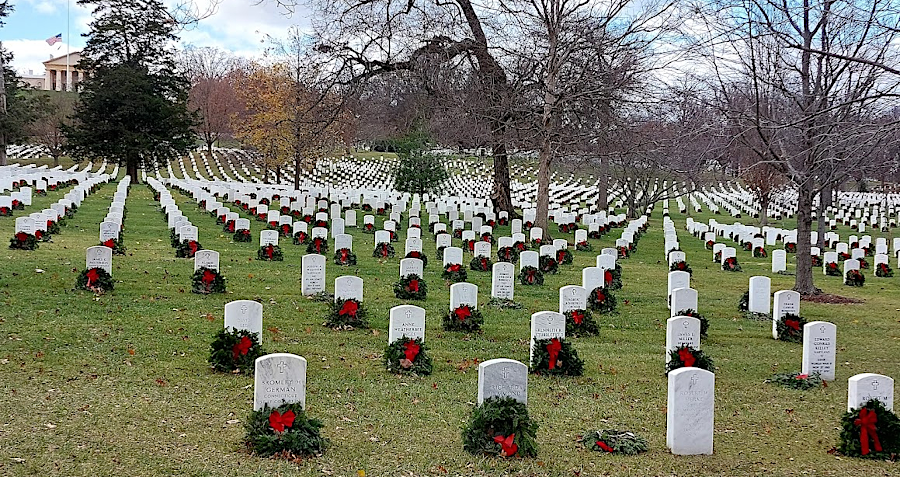
wreaths downhill from the mansion house at Arlington National Cemetery on December 18, 2023
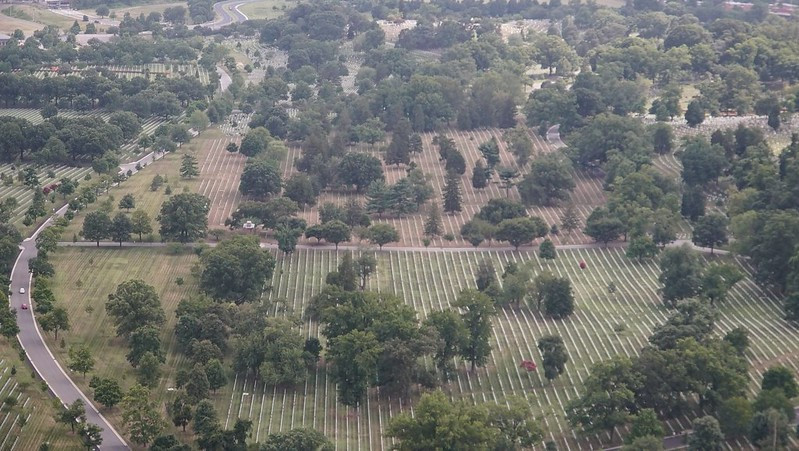
the alignment of graves in Arlington National Cemetery is linear, largely independent of the local topography
Source: Arlington County, Arlington County, as seen from the air
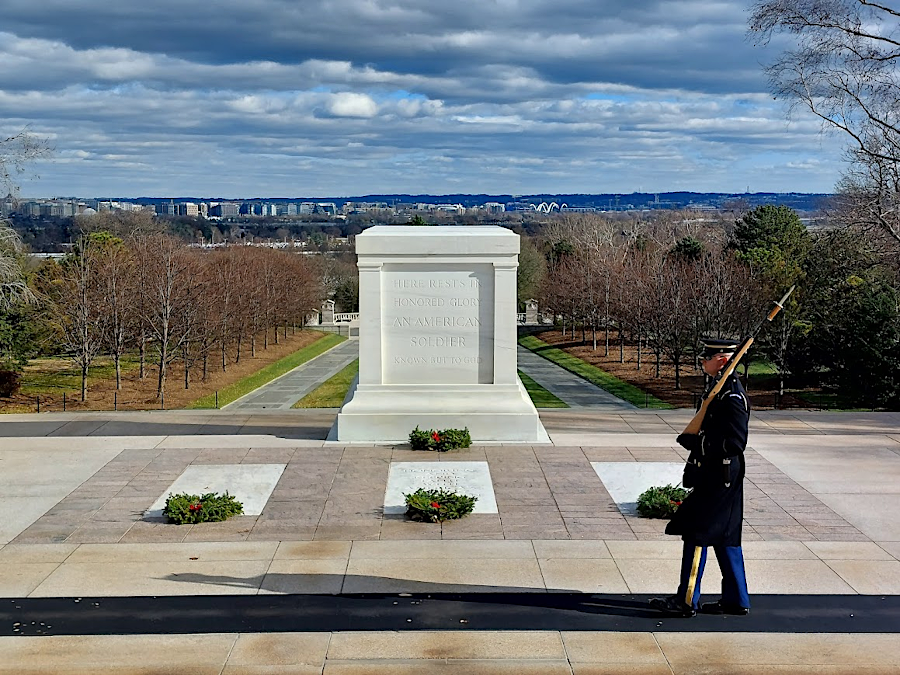
Tomb of the Unknowns in Arlington National Cemetery
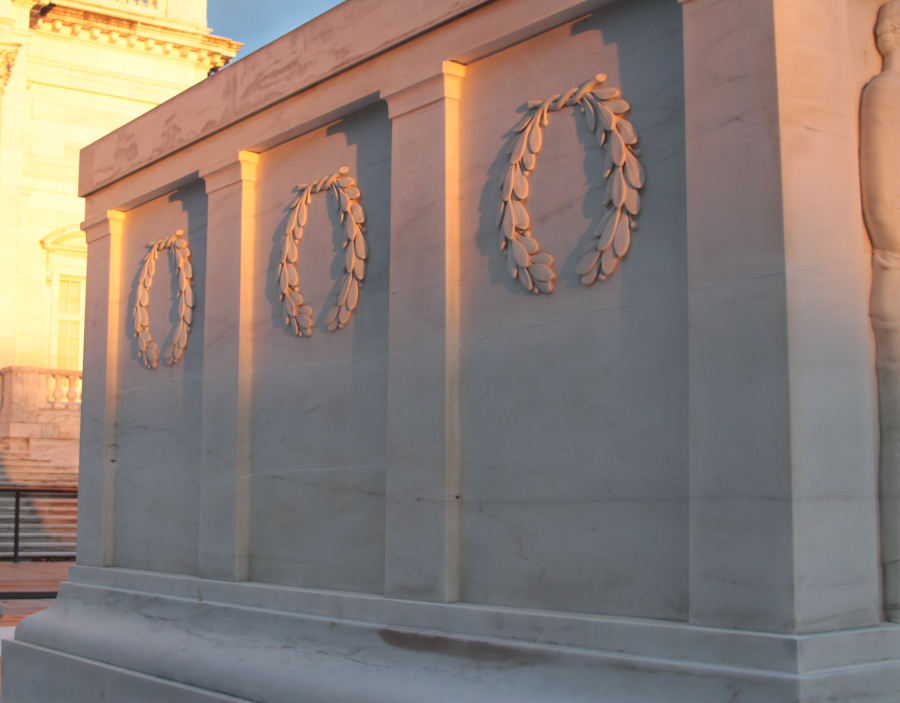
the crack in the marble of the Tomb of the Unknowns, as seen in 2011
Source: US Army Corps of Engineers, Norfolk District Image Gallery
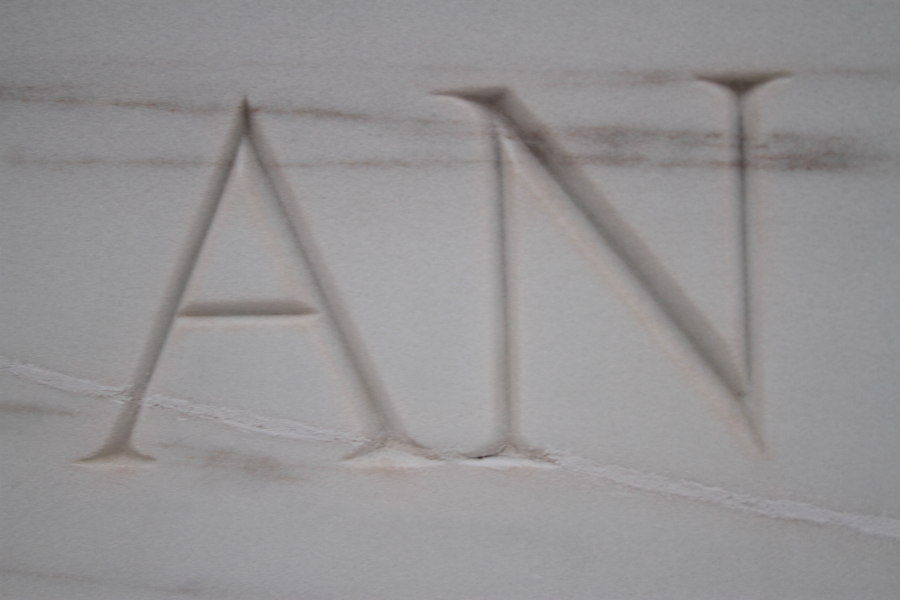
the crack in the marble of the Tomb of the Unknowns had been repaired prior to 2011
Source: US Army Corps of Engineers, Norfolk District Image Gallery
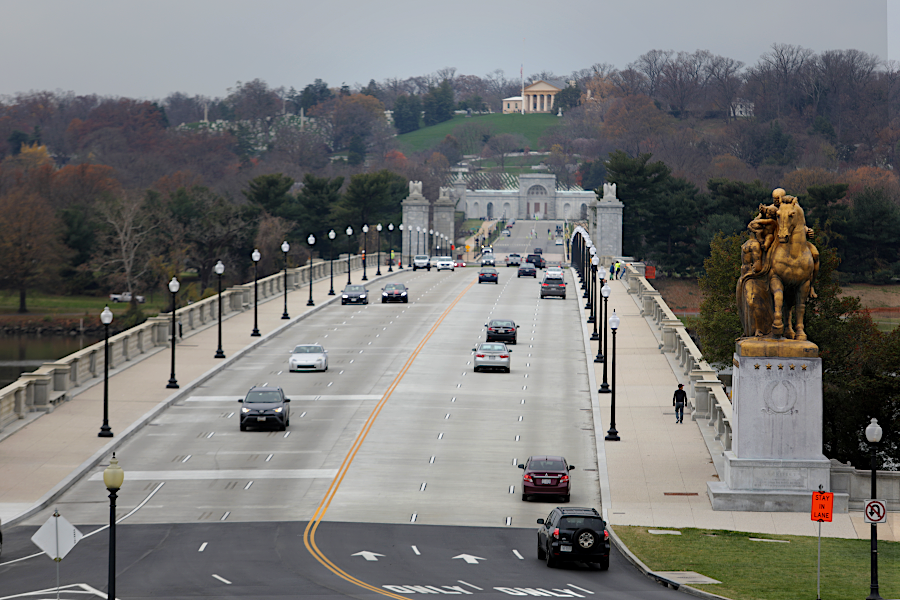
the Memorial Bridge provides drivers headed into Virginia a view of the former Lee mansion at Arlington National Cemetery
Source: National Park Service, More than a bridge: National Park Service completes full rehabilitation of Washington's ceremonial entrance
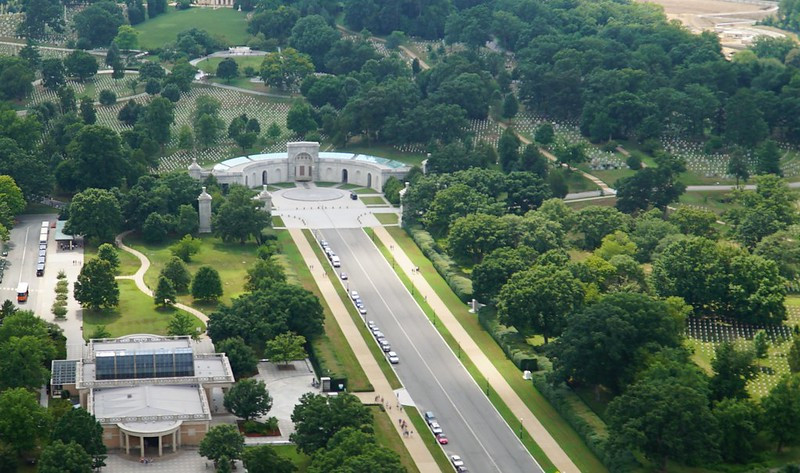
the road across Memorial Bridge stops at the entrance to Arlington National Cemetery
Source: Arlington County, Arlington County, as seen from the air
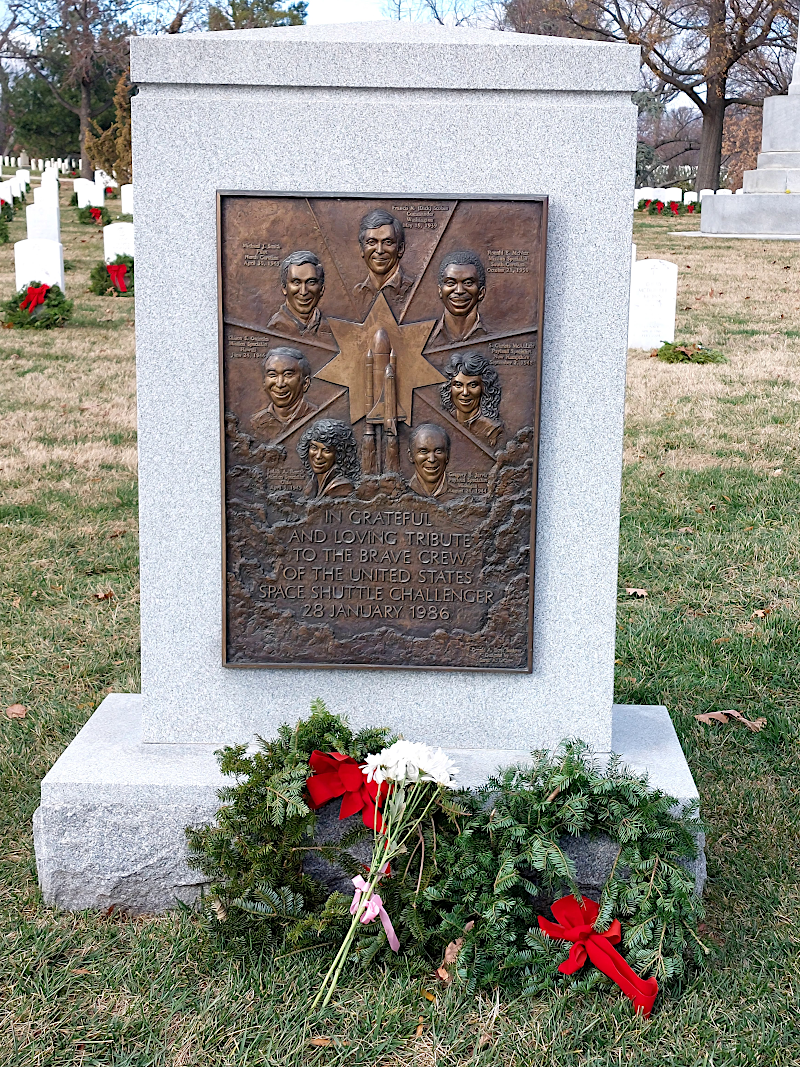
the comingled cremated remains of the seven Challenger astronauts are in Section 46, Grave 1129
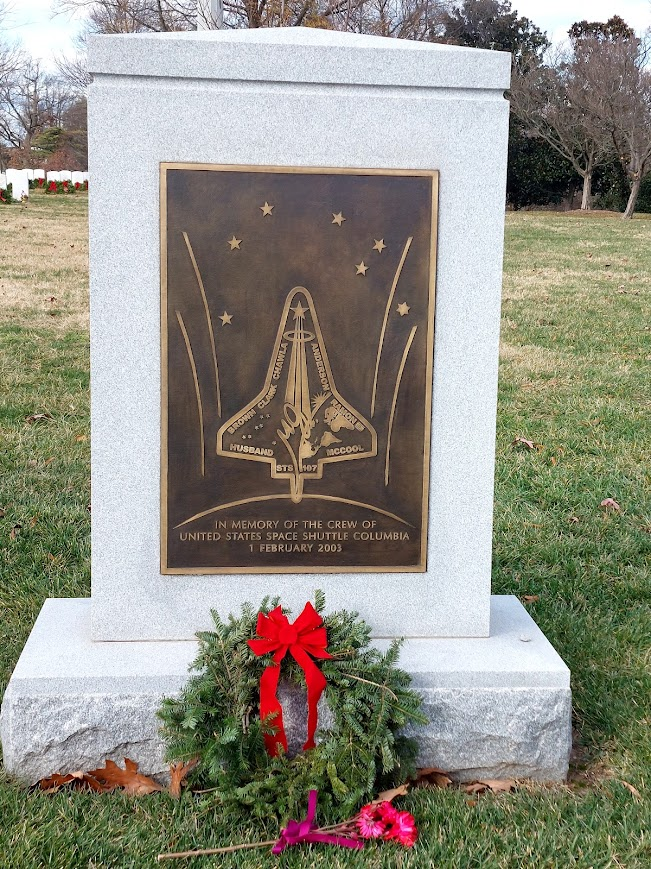
in addition to the Space Shuttle Columbia Memorial, three astronauts from that disastrous flight have individual graves at Arlington National Cemetery
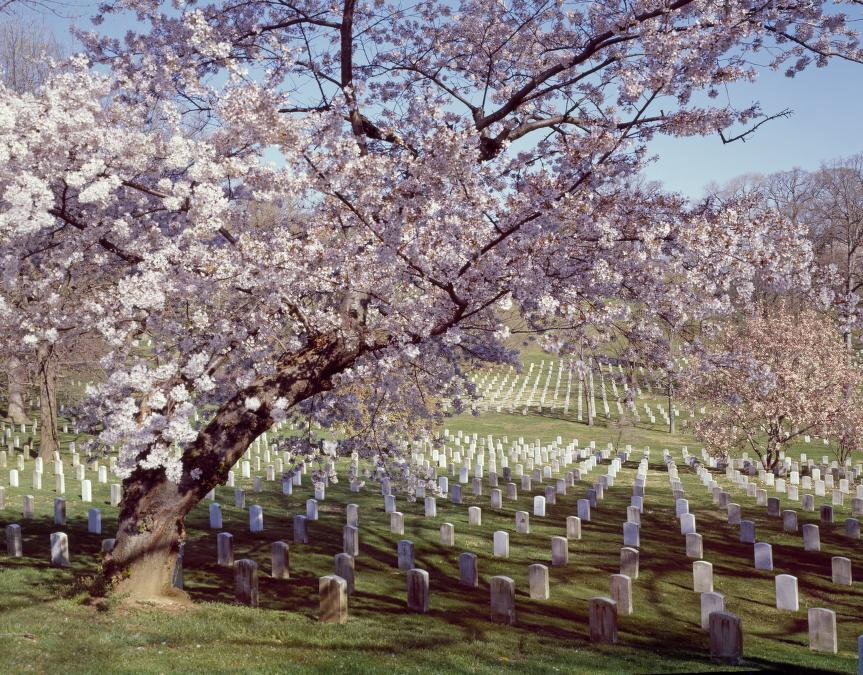
cherry trees at Arlington National Cemetery
Source: Library of Congress, Spring at Arlington National Cemetery, Arlington, Virginia
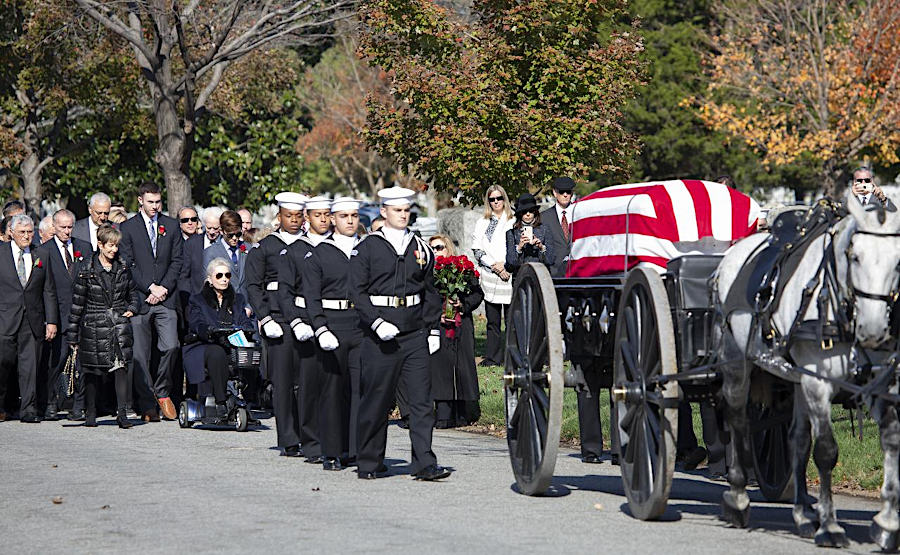
Alan Bean, fourth astronaut to walk on the moon, is one of many famous Americans buried at Arlington
Source: National Aeronautics and Space Administration (NASA), Alan Bean Interment (2018)
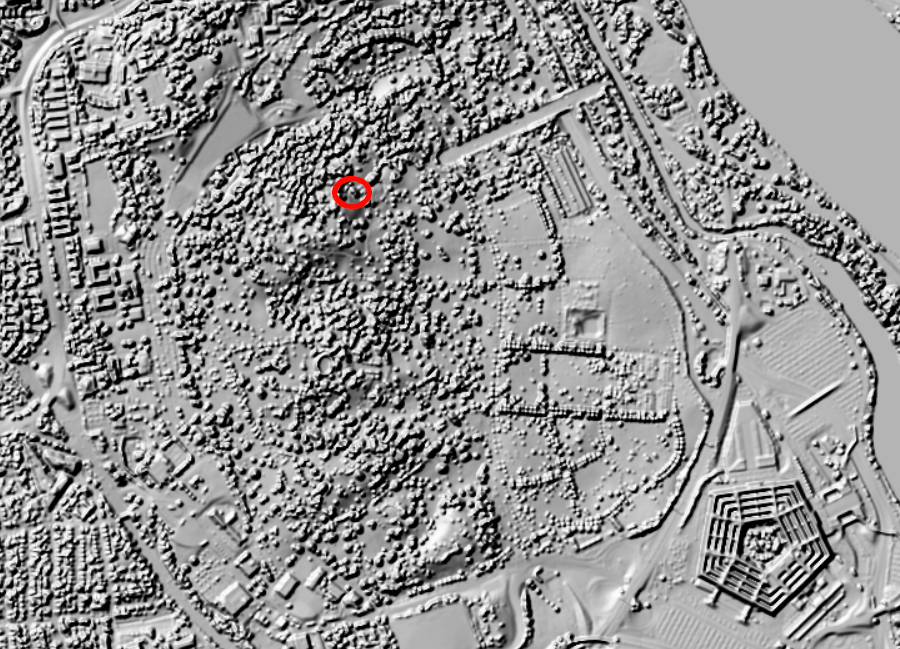
LIDAR reveals the topography around the Custis/Lee mansion house (red circle) at Arlington National Cemetery
Source: Fairfax County, LiDAR Digital Surface Model -2018
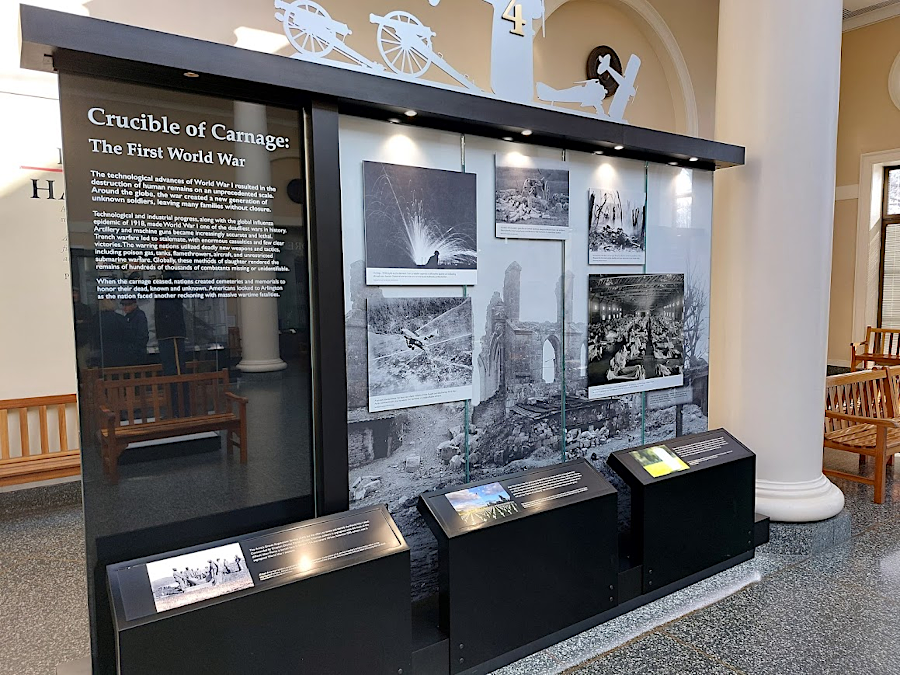
the evolution of Arlington Memorial Cemetery is told with exhibits inside the visitor center
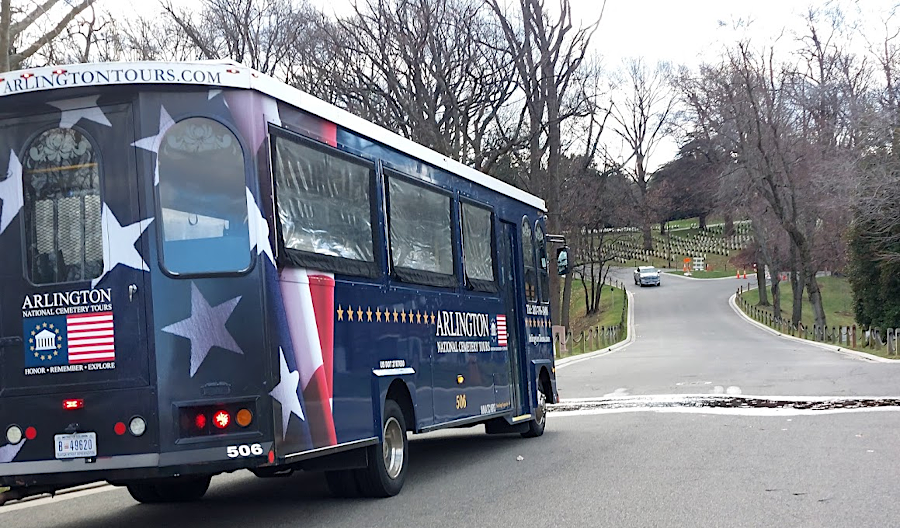
tour buses use the road network within Arlington National Cemetery
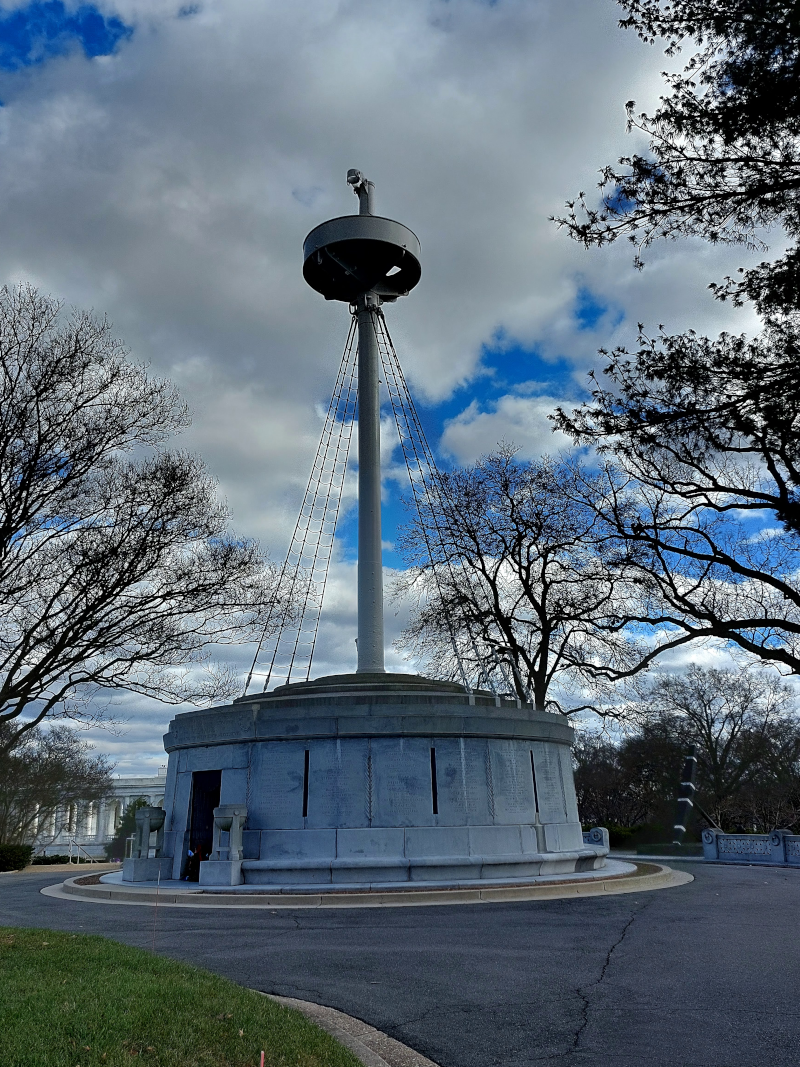
the ship's mast of the USS Maine is surrounded by the remains of 230 crew members